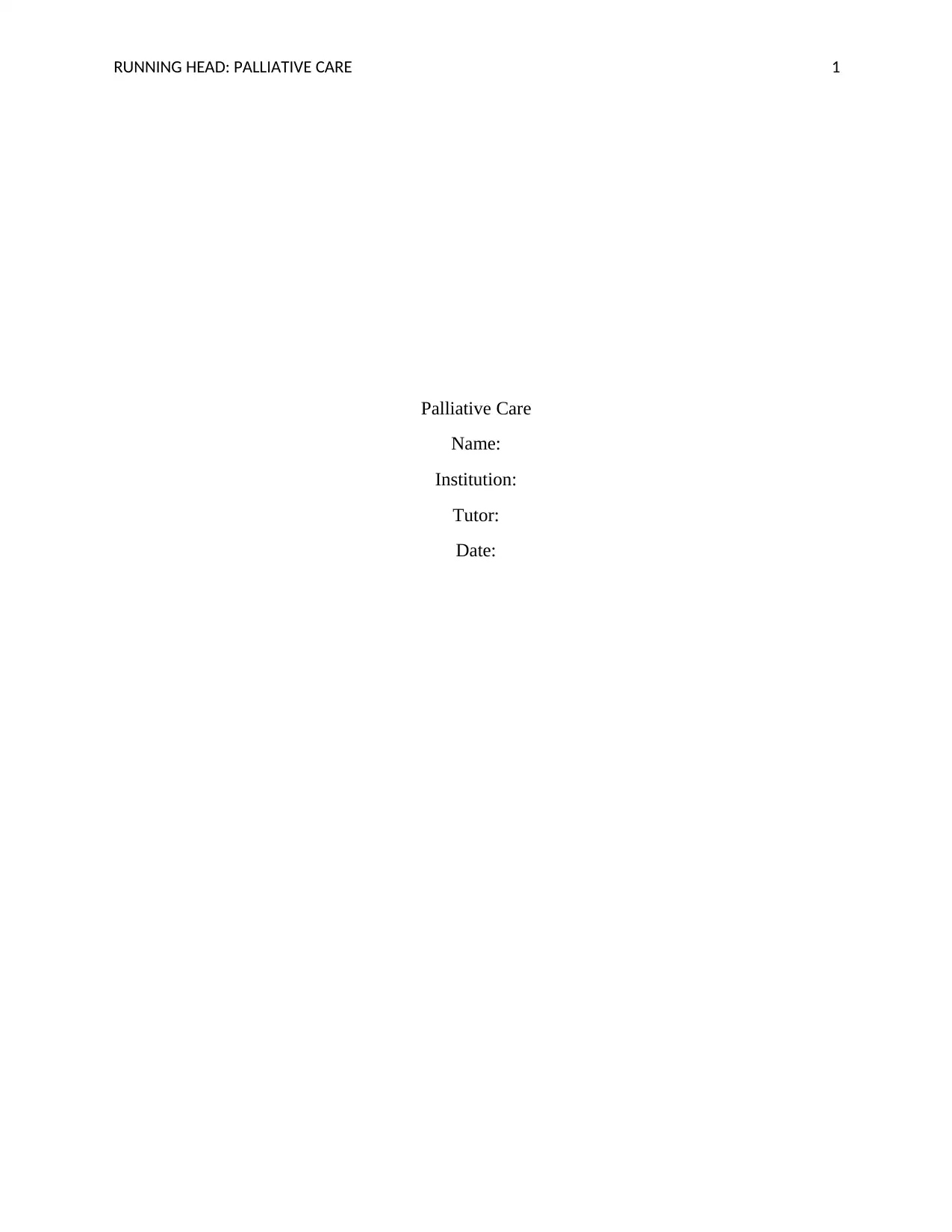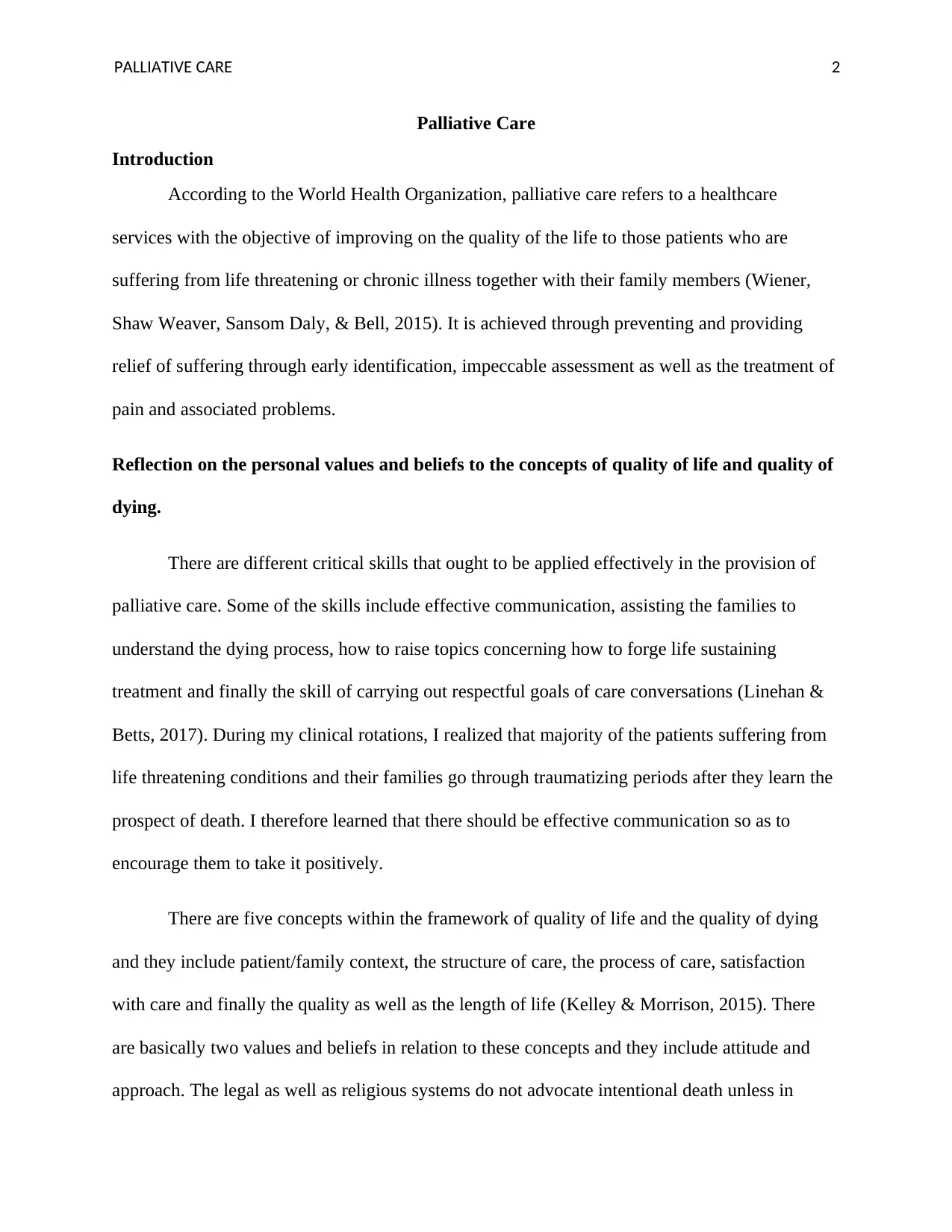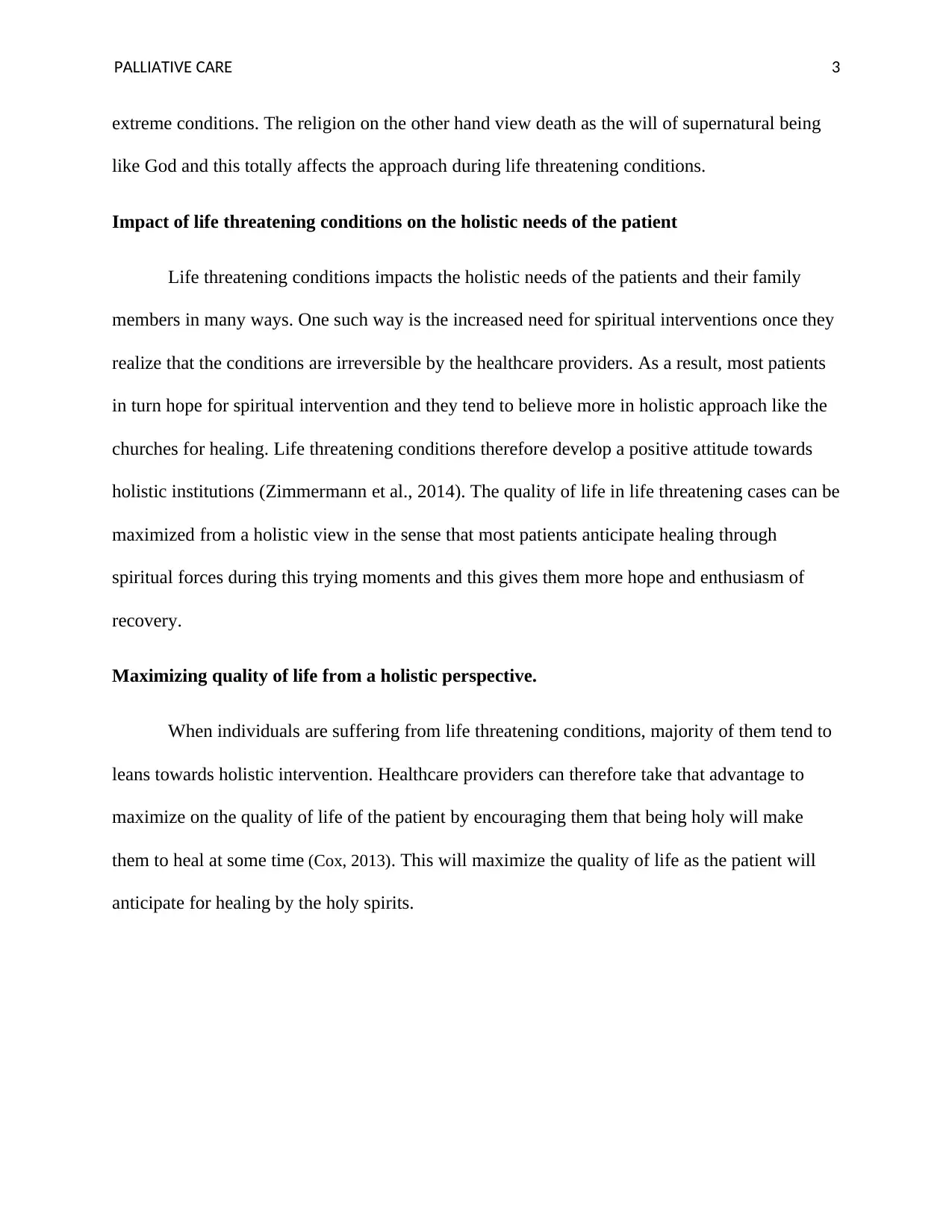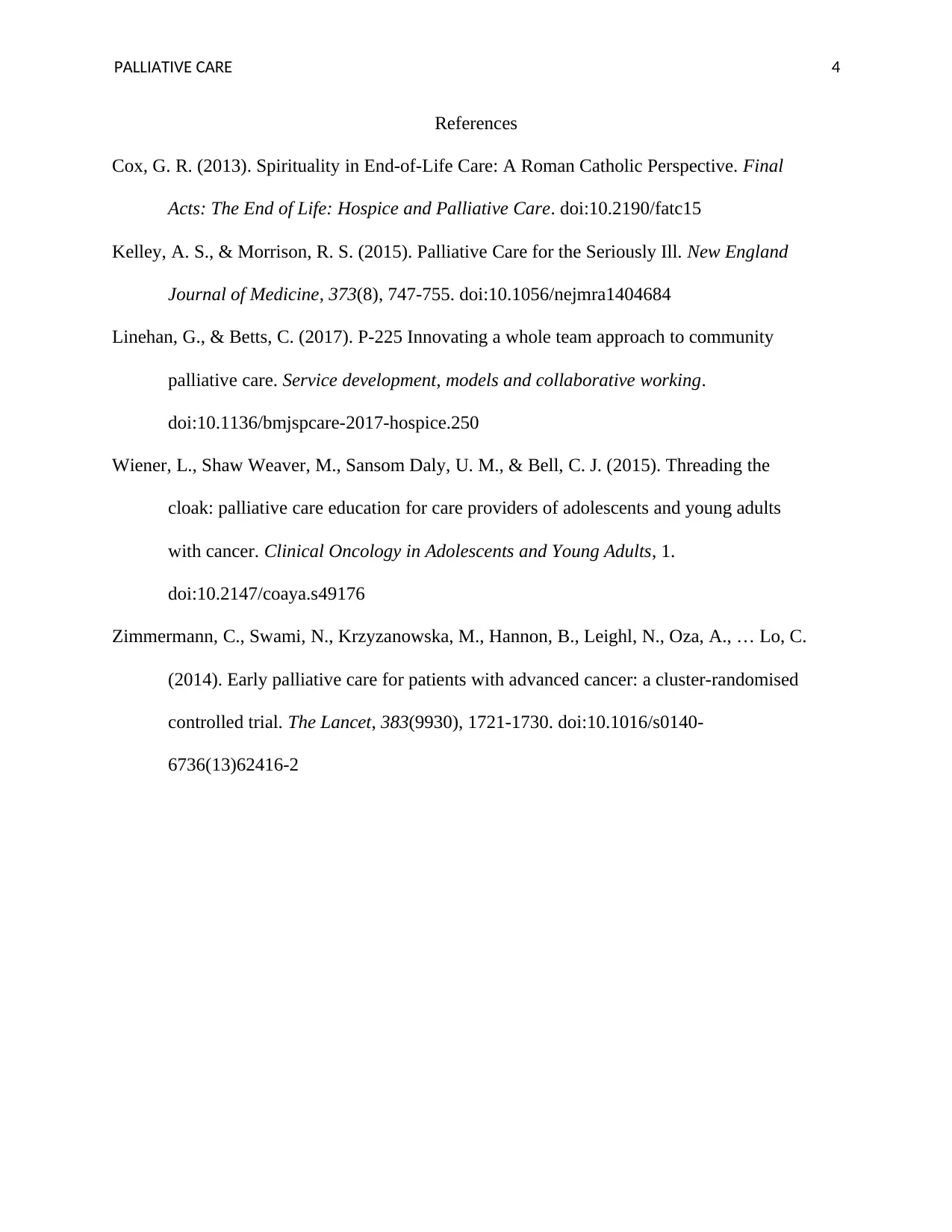Palliative Care: Improving Quality of Life in Life Threatening Cases
VerifiedAdded on 2023/06/11
|4
|800
|440
Essay
AI Summary
This essay provides an overview of palliative care, emphasizing its role in enhancing the quality of life for patients and their families facing life-threatening illnesses. It reflects on personal values and beliefs related to quality of life and dying, highlighting the importance of effective communication and addressing holistic needs. The essay discusses the impact of life-threatening conditions on patients' spiritual well-being and suggests maximizing quality of life through holistic interventions, such as encouraging spiritual beliefs to foster hope and enthusiasm for recovery. The conclusion emphasizes the significance of holistic care in palliative settings.

RUNNING HEAD: PALLIATIVE CARE 1
Palliative Care
Name:
Institution:
Tutor:
Date:
Palliative Care
Name:
Institution:
Tutor:
Date:
Paraphrase This Document
Need a fresh take? Get an instant paraphrase of this document with our AI Paraphraser

PALLIATIVE CARE 2
Palliative Care
Introduction
According to the World Health Organization, palliative care refers to a healthcare
services with the objective of improving on the quality of the life to those patients who are
suffering from life threatening or chronic illness together with their family members (Wiener,
Shaw Weaver, Sansom Daly, & Bell, 2015). It is achieved through preventing and providing
relief of suffering through early identification, impeccable assessment as well as the treatment of
pain and associated problems.
Reflection on the personal values and beliefs to the concepts of quality of life and quality of
dying.
There are different critical skills that ought to be applied effectively in the provision of
palliative care. Some of the skills include effective communication, assisting the families to
understand the dying process, how to raise topics concerning how to forge life sustaining
treatment and finally the skill of carrying out respectful goals of care conversations (Linehan &
Betts, 2017). During my clinical rotations, I realized that majority of the patients suffering from
life threatening conditions and their families go through traumatizing periods after they learn the
prospect of death. I therefore learned that there should be effective communication so as to
encourage them to take it positively.
There are five concepts within the framework of quality of life and the quality of dying
and they include patient/family context, the structure of care, the process of care, satisfaction
with care and finally the quality as well as the length of life (Kelley & Morrison, 2015). There
are basically two values and beliefs in relation to these concepts and they include attitude and
approach. The legal as well as religious systems do not advocate intentional death unless in
Palliative Care
Introduction
According to the World Health Organization, palliative care refers to a healthcare
services with the objective of improving on the quality of the life to those patients who are
suffering from life threatening or chronic illness together with their family members (Wiener,
Shaw Weaver, Sansom Daly, & Bell, 2015). It is achieved through preventing and providing
relief of suffering through early identification, impeccable assessment as well as the treatment of
pain and associated problems.
Reflection on the personal values and beliefs to the concepts of quality of life and quality of
dying.
There are different critical skills that ought to be applied effectively in the provision of
palliative care. Some of the skills include effective communication, assisting the families to
understand the dying process, how to raise topics concerning how to forge life sustaining
treatment and finally the skill of carrying out respectful goals of care conversations (Linehan &
Betts, 2017). During my clinical rotations, I realized that majority of the patients suffering from
life threatening conditions and their families go through traumatizing periods after they learn the
prospect of death. I therefore learned that there should be effective communication so as to
encourage them to take it positively.
There are five concepts within the framework of quality of life and the quality of dying
and they include patient/family context, the structure of care, the process of care, satisfaction
with care and finally the quality as well as the length of life (Kelley & Morrison, 2015). There
are basically two values and beliefs in relation to these concepts and they include attitude and
approach. The legal as well as religious systems do not advocate intentional death unless in

PALLIATIVE CARE 3
extreme conditions. The religion on the other hand view death as the will of supernatural being
like God and this totally affects the approach during life threatening conditions.
Impact of life threatening conditions on the holistic needs of the patient
Life threatening conditions impacts the holistic needs of the patients and their family
members in many ways. One such way is the increased need for spiritual interventions once they
realize that the conditions are irreversible by the healthcare providers. As a result, most patients
in turn hope for spiritual intervention and they tend to believe more in holistic approach like the
churches for healing. Life threatening conditions therefore develop a positive attitude towards
holistic institutions (Zimmermann et al., 2014). The quality of life in life threatening cases can be
maximized from a holistic view in the sense that most patients anticipate healing through
spiritual forces during this trying moments and this gives them more hope and enthusiasm of
recovery.
Maximizing quality of life from a holistic perspective.
When individuals are suffering from life threatening conditions, majority of them tend to
leans towards holistic intervention. Healthcare providers can therefore take that advantage to
maximize on the quality of life of the patient by encouraging them that being holy will make
them to heal at some time (Cox, 2013). This will maximize the quality of life as the patient will
anticipate for healing by the holy spirits.
extreme conditions. The religion on the other hand view death as the will of supernatural being
like God and this totally affects the approach during life threatening conditions.
Impact of life threatening conditions on the holistic needs of the patient
Life threatening conditions impacts the holistic needs of the patients and their family
members in many ways. One such way is the increased need for spiritual interventions once they
realize that the conditions are irreversible by the healthcare providers. As a result, most patients
in turn hope for spiritual intervention and they tend to believe more in holistic approach like the
churches for healing. Life threatening conditions therefore develop a positive attitude towards
holistic institutions (Zimmermann et al., 2014). The quality of life in life threatening cases can be
maximized from a holistic view in the sense that most patients anticipate healing through
spiritual forces during this trying moments and this gives them more hope and enthusiasm of
recovery.
Maximizing quality of life from a holistic perspective.
When individuals are suffering from life threatening conditions, majority of them tend to
leans towards holistic intervention. Healthcare providers can therefore take that advantage to
maximize on the quality of life of the patient by encouraging them that being holy will make
them to heal at some time (Cox, 2013). This will maximize the quality of life as the patient will
anticipate for healing by the holy spirits.
⊘ This is a preview!⊘
Do you want full access?
Subscribe today to unlock all pages.

Trusted by 1+ million students worldwide

PALLIATIVE CARE 4
References
Cox, G. R. (2013). Spirituality in End-of-Life Care: A Roman Catholic Perspective. Final
Acts: The End of Life: Hospice and Palliative Care. doi:10.2190/fatc15
Kelley, A. S., & Morrison, R. S. (2015). Palliative Care for the Seriously Ill. New England
Journal of Medicine, 373(8), 747-755. doi:10.1056/nejmra1404684
Linehan, G., & Betts, C. (2017). P-225 Innovating a whole team approach to community
palliative care. Service development, models and collaborative working.
doi:10.1136/bmjspcare-2017-hospice.250
Wiener, L., Shaw Weaver, M., Sansom Daly, U. M., & Bell, C. J. (2015). Threading the
cloak: palliative care education for care providers of adolescents and young adults
with cancer. Clinical Oncology in Adolescents and Young Adults, 1.
doi:10.2147/coaya.s49176
Zimmermann, C., Swami, N., Krzyzanowska, M., Hannon, B., Leighl, N., Oza, A., … Lo, C.
(2014). Early palliative care for patients with advanced cancer: a cluster-randomised
controlled trial. The Lancet, 383(9930), 1721-1730. doi:10.1016/s0140-
6736(13)62416-2
References
Cox, G. R. (2013). Spirituality in End-of-Life Care: A Roman Catholic Perspective. Final
Acts: The End of Life: Hospice and Palliative Care. doi:10.2190/fatc15
Kelley, A. S., & Morrison, R. S. (2015). Palliative Care for the Seriously Ill. New England
Journal of Medicine, 373(8), 747-755. doi:10.1056/nejmra1404684
Linehan, G., & Betts, C. (2017). P-225 Innovating a whole team approach to community
palliative care. Service development, models and collaborative working.
doi:10.1136/bmjspcare-2017-hospice.250
Wiener, L., Shaw Weaver, M., Sansom Daly, U. M., & Bell, C. J. (2015). Threading the
cloak: palliative care education for care providers of adolescents and young adults
with cancer. Clinical Oncology in Adolescents and Young Adults, 1.
doi:10.2147/coaya.s49176
Zimmermann, C., Swami, N., Krzyzanowska, M., Hannon, B., Leighl, N., Oza, A., … Lo, C.
(2014). Early palliative care for patients with advanced cancer: a cluster-randomised
controlled trial. The Lancet, 383(9930), 1721-1730. doi:10.1016/s0140-
6736(13)62416-2
1 out of 4
Related Documents
Your All-in-One AI-Powered Toolkit for Academic Success.
+13062052269
info@desklib.com
Available 24*7 on WhatsApp / Email
![[object Object]](/_next/static/media/star-bottom.7253800d.svg)
Unlock your academic potential
Copyright © 2020–2025 A2Z Services. All Rights Reserved. Developed and managed by ZUCOL.





